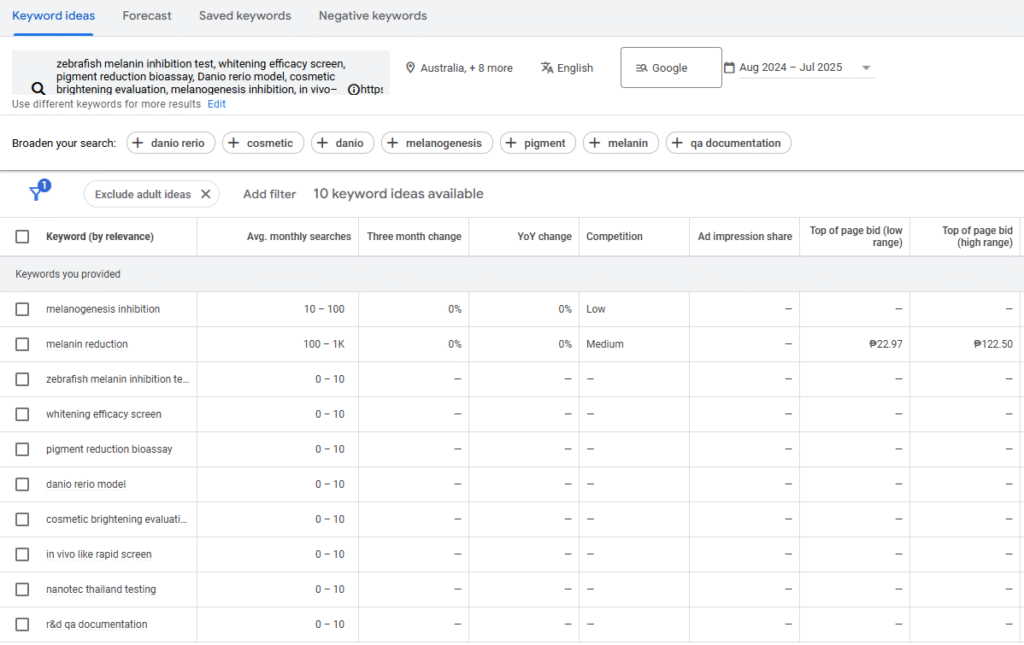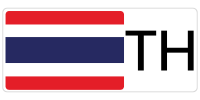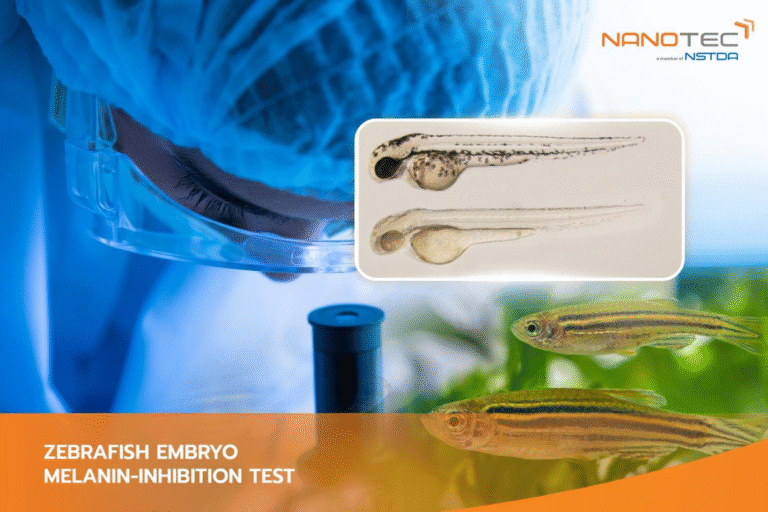Meta description (140–160): Screen whitening/brightening claims fast with NANOTEC’s zebrafish embryo melanin-inhibition assay, quantitative % inhibition with concurrent acute-toxicity observation in a transparent, high-throughput vertebrate model.
SEO keywords (one line): zebrafish melanin inhibition test, whitening efficacy screen, pigment reduction bioassay, Danio rerio model, cosmetic brightening evaluation, melanogenesis inhibition, in vivo–like rapid screen, NANOTEC Thailand testing, % melanin reduction, R&D QA documentation

Why This Test Matters
If your product or active ingredient targets skin brightening or melanin modulation, you need an efficacy screen that is fast, visual, and quantitative yet still practical for early development and supplier qualification. The zebrafish embryo melanin-inhibition test provides exactly that. Zebrafish (Danio rerio) embryos are transparent, develop rapidly, and produce visible pigment granules as melanocytes mature. That means you can see and quantify the impact of your material on melanogenesis without complex or time-consuming procedures.
Because this is a vertebrate model with high genetic homology to humans, results serve as a meaningful preclinical signal ahead of more costly or lengthy studies (e.g., expanded in-vitro cell panels or later human testing). At NANOTEC, the assay is implemented as an in-house developed method optimized for cosmetics and health-product R&D. It provides a percent inhibition (% inhibition) readout benchmarked to a vehicle control, together with a concurrent acute-toxicity check over the exposure window so you can judge efficacy and tolerability from the same run.
Use it to:
- Prioritize candidate actives, extracts, or encapsulated ingredients for brightening/lightening claims
- Compare supplier lots or formulation variants on an equal footing
- Substantiate internal go/no-go decisions and de-risk further development
- Augment product dossiers with clear, visual evidence of activity
What the Test Measures
Principle. Fertilized zebrafish embryos are exposed to your test item at defined concentration(s) during the window when melanocytes form and deposit melanin. Because embryos are naturally transparent, pigmentation is readily observed. After a defined exposure period (with standard observations commonly ~48 hours in this method), embryos are evaluated for relative melanin content versus a control group. The primary endpoint is % inhibition of melanin formation compared with the untreated control. During the same window, we observe for acute-toxicity signs to help separate true efficacy from generalized toxicity.
Typical outputs you receive:
- % melanin inhibition vs. control for the tested concentration(s)
- Qualitative/quantitative toxicity notes captured during the exposure period (e.g., “no acute toxicity observed under test conditions” or “toxicity signs at ≥X concentration”)
- Method summary (exposure window, observation schedule, imaging conditions)
- Representative images of embryos (optional add-on) to visualize pigmentation differences
- Interpretive note to support next steps (e.g., “progress to dose–response refinement” or “pair with in-vitro cytotoxicity for a wider safety window”)
Need a dose–response curve? We can structure the study across multiple concentrations to profile activity and identify a practical operating range.
When to Choose the Zebrafish Melanin-Inhibition Assay
- Claim building for brightening/lightening concepts in cosmetics and cosmeceuticals
- Screening herbal extracts or encapsulated actives where stability and delivery may influence efficacy
- Rapid triage of candidate ingredients before committing to larger cell-based or clinical explorations
- Differentiation among suppliers or batches when melanin-related performance matters
If your primary question is general acute hazard, consider the Zebrafish Embryo Acute Toxicity Test (OECD TG 236). For chromosomal genotoxicity, see In-vitro Micronucleus (OECD 487). Many clients run the melanin-inhibition assay alongside one or both to assemble a balanced efficacy–safety picture.
Study Design & Workflow
- Scoping & Intake
- Define objective (screening vs. comparative; single dose vs. multi-dose).
- Confirm test matrix (liquid or powder), expected solubility/dispersion behavior, and any light or pH sensitivities.
- Align on observation window and documentation depth (tables only vs. tables + images).
- Execution
- Prepare exposures with appropriate controls.
- Maintain embryos under controlled temperature/lighting; record melanin development and tolerability at scheduled timepoints.
- Capture images under consistent conditions if the photo-documentation option is selected.
- Analysis & Reporting
- Calculate % inhibition relative to control.
- Summarize toxicity observations from the exposure period.
- Provide a decision-ready report with methods, results, and concise interpretation.
Reporting You Can Use
Your report is structured for QA review and partner communication:
- Results table: % melanin inhibition by concentration (if multiple levels)
- Toxicity observation summary during the exposure window (to support safety interpretation)
- Method summary: in-house zebrafish embryo melanin-inhibition method; exposure duration; environmental conditions; imaging (if applicable)
- Representative images (optional) to visualize pigment differences
- Recommendations: suggested follow-ups (e.g., refine dose range; add in-vitro cytotoxicity or OECD TG 236)
Report language & delivery
NANOTEC issues decision-ready test reports in Thai or English (one language included). A second language copy can be provided for an additional THB 500. Reports can be delivered by hand, via email, or by post (postal delivery incurs an additional shipping charge).
Sample Guidance
To reduce ambiguity and retests, please follow these preparation guidelines.
Accepted sample forms & minimum quantities (per sample):
- Liquids: 100 mL
- Powders: 60 mg
Labeling & documentation:
- Clearly label sample name, lot/batch, and intended test (“Zebrafish Melanin-Inhibition”).
- Provide an SDS (if available) and note any handling constraints (e.g., volatile, oxidizing, light-sensitive).
- Share solubility/dispersion notes. If a vehicle, surfactant, or mild pH adjustment is needed, we will agree the approach during scoping.
Transport & storage:
- Seal and pack to prevent leaks or contamination.
- If temperature-sensitive, indicate storage needs; ship with appropriate cold packs if required.
Planning to test encapsulated actives? Let us know the carrier type (e.g., lipidic, polymeric) and any release characteristics you expect to see during the window; this helps us interpret efficacy signals.
Sample return & storage
After testing, you may choose to have remaining samples destroyed or returned. Returned samples can be picked up in person or shipped by post (shipping charge applies). If samples are not collected within 30 days of report delivery, NANOTEC will dispose of them. During intake, storage conditions are recorded (e.g., room temperature, chilled, desiccator).
Who This Service Is For
- Cosmetics & cosmeceuticals developers building brightening/whitening claims or vetting supplier extracts
- Formulation R&D teams optimizing delivery systems (e.g., nanoencapsulation) for pigment-related outcomes
- Botanical/ingredient suppliers needing an independent activity screen to support customer discussions
- Startups/SMEs seeking a quick, defendable efficacy readout prior to more resource-intensive studies
Complementary & Follow-On Tests
- Zebrafish Embryo Acute Toxicity (OECD TG 236) – pairs naturally with melanin-inhibition to distinguish efficacy from acute toxicity during the same developmental window.
- In-vitro Cytotoxicity (ISO 10993-5) – cell-viability and IC₅₀ estimation to frame a preliminary safety margin.
- In-vitro Micronucleus (OECD 487) – a genotoxicity screen at the chromosomal level.
- Stability & Chemistry – optional checks (e.g., FTIR/GC-MS or stability studies) to ensure your active remains intact across the exposure window.
- Contact Angle / Deposition – if you are exploring topical delivery, these physical tests can inform how a formulation might behave on skin surfaces.
Together, these create a balanced efficacy–safety narrative suitable for internal gates, partner evaluations, or early regulatory dialogue.
Pricing Overview
- Zebrafish embryo melanin-inhibition test (in-house method): from THB 130,000 per sample (excl. VAT)
Notes: Final pricing depends on the number of concentrations, documentation depth (e.g., image sets), and any special handling. We will confirm scope and fee in a written quotation before work begins.
How to Get Started
- Tell us your goal – screening vs. comparative; single dose vs. multi-dose.
- Share sample details – form (liquid/powder), solubility notes, handling constraints.
- Agree the plan – exposure window, concentrations, outputs (tables only vs. tables + images).
- Ship samples – follow the quantities above; include labeling and SDS/notes.
- Receive your report – clear % inhibition results, toxicity observations, and next-step guidance.
Suggested Internal Links
- Zebrafish Embryo Acute Toxicity Test (OECD TG 236)
- In-vitro Cytotoxicity (ISO 10993-5)
- In-vitro Micronucleus (OECD 487)
- Chemical & Physical Analysis Hub (e.g., particle size, FTIR/GC-MS)
- Stability & Shelf-Life Testing
Contact
National Nanotechnology Center (NANOTEC) – Infrastructure Services
143 INC 2 (B), Thailand Science Park, Phahonyothin Road,
Khlong Nueng, Khlong Luang, Pathum Thani 12120, Thailand
Tel. +66 2 564 7100 ext. 6517, 6625, 6680
Email: bdis-infs@nanotec.or.th
Turn brightening concepts into data. The zebrafish embryo melanin-inhibition assay gives you a fast, visual, and quantitative read on melanogenesis: ideal for prioritizing actives, comparing suppliers, and building confident claims


